What's New
Displaying results 311 - 320 of 4052
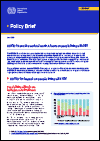
Resource | Publications,
Part of the ILO series on leaving no one behind in COVID-19 and the world of work, this brief describes the impact of the pandemic on people living with HIV and makes recommendations for a COVID-19 response and recovery in the world of work that is inclusive of people living with HIV.
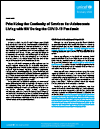
Prioritizing the Continuity of Services for Adolescents Living with HIV during the COVID-19 Pandemic
Resource | Publications,
This information note is intended for use by policy makers, programme managers, and major funders of the health sector response to HIV, in contexts where COVID-19 poses a threat to service continuity for adolescents living with HIV, within national COVID-19 responses. The document succinctly summarizes what we know about COVID-19 risks in this vulnerable population, offers key considerations for safeguarding HIV treatment service continuity, and emphasizes sexual and reproductive health, mental health and psychosocial support as priority needs.

Resource | Publications,
This policy brief is for country-level programme managers, technical advisers and procurement bodies involved in the process of procuring, introducing and scaling up optimal antiretroviral therapy for infants and young children living with HIV in low and middle-income countries. With multiple new antiretroviral drug options and the availability of new evidence, antiretroviral therapy for children is a dynamic and rapidly evolving space. Although critical tools such as the antiretroviral drug optimal formulary are periodically updated to support product selection, programmes must stay informed and up to date on availability of currently used antiretroviral drug formulations for children and anticipated new products to ensure that all children have access to the best available treatment for HIV infection.
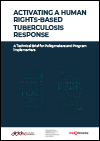
Resource | Publications,
A human rights-based TB response supports and enhances public health measures and good clinical practice. The approach is founded on the dignity and autonomy of people affected by TB and the critical role they must play in all aspects of the disease response. A rights-based approach places special focus on TB key and vulnerable populations, it demands a gender-sensitive response, and it leverages existing law at international, regional, and national levels to strengthen the response. This includes the rights to health, nondiscrimination, privacy & confidentiality, information, liberty, and others. Respect for these human rights promotes the health and well-being of individuals and, in doing so, protects the public’s health.
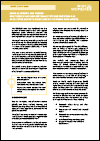
Resource | Publications,
The Covid-19 crisis has highlighted the dire situation of overcrowded prisons and triggered discussions about alternative sanctions that effectively reduces crime rates and recidivism while ensuring health and safety of the prison population. Women, particularly in Asia, are incarcerated at an increasing rate and for non-violent offenses. This brief explores the use of early release and alternative sentencing to effectively curb populations, thereby reducing the threat of Covid-19 due to overcrowding.
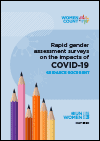
Resource | Publications,
This guidance document on implementing rapid gender assessment surveys on the impacts of COVID-19 was developed by UN Women’s global gender data programme, Making Every Woman and Girl Count (Women Count),1 to increase the programme’s relevance in response to the COVID-19 crisis, while continuously delivering on its core objectives.

Resource | Publications,
COVID-19 has affected men and women differently. Although more men have died from the pandemic, women’s mental health is taking a bigger toll, their workload at home has multiplied and their economic resources are dwindling.
These effects are hard to capture, as social distancing measures have rendered traditional data collection methods impossible. In response to this challenge, UN Women’s Regional Office for Asia and Pacific turned to innovative solutions to pursue data collection at this critical time.
UN Women engaged with national governments and mobile network operators to roll out a series of rapid assessment surveys in 11 Asia-Pacific countries. As data collection began within a week of the pandemic being declared, results are now available to guide policy makers in their responses.
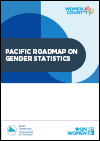
Resource | Publications,
The purpose of the roadmap is to provide the guiding framework to support Pacific National Statistical Systems to generate quality, relevant and timely gender data that meets users’ needs to advance gender equality. The roadmap aims to result in quality, relevant and timely gender data that responds to users’ needs is produced, available, disseminated and effectively used to advance gender equality. It has been designed by gender data users and producers through collective effort to further enhance user-producer dialogue and ownership of gender statistics across the Pacific.
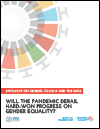
Resource | Publications,
COVID-19 has been declared a public health emergency of international concern and a global pandemic by the World Health Organization. This global threat to health security underscores the urgent need to accelerate progress on achieving Sustainable Development Goal (SDG) 3 and the need to massively scale up international cooperation to deliver on SDG 3. It also reveals what is less obvious, but no less urgent: how health emergencies such as COVID-19, and the response to them, can exacerbate gender inequality and derail hard-won progress not only on SDG 3 but on all of the SDGs. This Spotlight paper presents the latest evidence on the gendered impact of the pandemic, highlights potential and emerging trends, and reflects on the long-term impact of the crisis on the achievement of the 2030 Agenda for Sustainable Development.
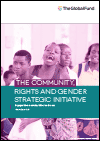
Resource | Publications,
The Community, Rights and Gender Strategic Initiative (CRG SI) is a three-year $15-million catalytic investment, aimed at strengthening the meaningful engagement of civil society and communities in Global Fund-related processes.
It works through three mutually reinforcing components: (1) A short-term technical assistance program, (2) long-term capacity strengthening of key and vulnerable population networks and organizations, and (3) six regional communication and coordination platforms.





